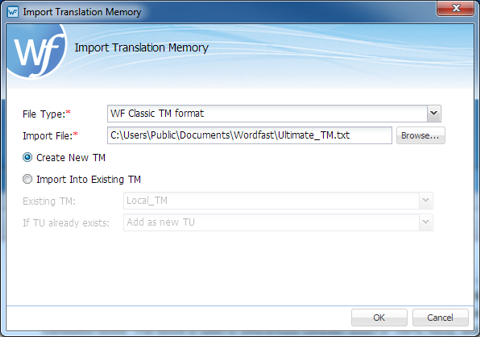

- WORDFAST CLASSIC CREATE AND USE A TM MOVIE
- WORDFAST CLASSIC CREATE AND USE A TM PRO
- WORDFAST CLASSIC CREATE AND USE A TM LICENSE
- WORDFAST CLASSIC CREATE AND USE A TM PROFESSIONAL
WORDFAST CLASSIC CREATE AND USE A TM PRO
Wordfast Pro (this FAQ, the latest version is Wordfast Pro 4 and can be downloaded here: ).Please contact an attorney regarding your particular legal issues.There are several different tools belonging to the Wordfast "family":
WORDFAST CLASSIC CREATE AND USE A TM PROFESSIONAL
Notice: This post is for informational purposes only and is not a substitute for professional advice based on a review of individual circumstances. Read "Copyright in Characters: What Can I Use? Part II" Note: this Q&A was modified to remove the name of the video game referenced in the original question.
WORDFAST CLASSIC CREATE AND USE A TM LICENSE
You can’t stop someone from suing you (even if you’re right), and using a famous character may not be worth the risk of a lawsuit, so think about getting a license or using your own original character before attempting to use a famous character. Lucasfilm also vigilantly polices its trademarks and copyrights, so I recommend steering clear of that territory.Ĭharacters can be protected by several theories of law, including copyright law, trademark law, and rights of publicity. So even making a robot that brings to mind R2-D2 could be trademark infringement. Trademarks are source indicators and trademark law is concerned with likelihood of confusion. The other thing about Lucasfilm though, is that they have many of their works trademarked as well. But the expression of a robot with three legs, half-sphere for a head, cylindrical, with blue and white ornamentation? Definitely protected - it's Lucas's expression of a robot. So how about using a picture of a robot that looks very similar to R2-D2? Like I said earlier, the idea of robots is not protected. That's the area of trademark law, and there may certainly be trademark law issues going on there, as well as rights of publicity. This alone likely doesn’t infringe the copyright of someone else’s work if the game’s character art and scenery are original creations developed by the game company.ĭo they bring to mind other notable characters in pop culture because of the context? Totally! But copyright law isn't concerned about that here.
WORDFAST CLASSIC CREATE AND USE A TM MOVIE
The creators of some video games use stock characters and scenery that resemble famous movie franchises. So just mentioning the name of a character won’t be copyright infringement without more.

Consequently, any use of a gun-toting cyborg won’t be considered copyright infringement of RoboCop until that cyborg looks and acts like RoboCop.Īlso, names alone do not have copyright protection. As I said earlier, copyright law does not protect stock characters. For video games though, the unique expression is the actual visual character created by the artist.įamous franchise movie characters, like Rambo, Snake Plisskin, and RoboCop, are protected by copyright law because of the copyright in the film and script, but only to the extent of the creative expression by the author. This line can get pretty blurry, especially in the context of written stories since there often isn’t a visual element and the author must describe the character with sufficient originality.

Concepts like robots, men in black, beefy army dudes with guns, samurai, etc., are called “stock” characters, and don't rise to the standard of creative until the author adds something more or expresses that concept. drawing your own rendition of something or adding certain attributes. Actual copying of the expression of the idea is likely copyright infringement, especially in the commercial context, however copying only the basic idea behind the work is copying unprotected ideas and isn't copyright infringement.įor characters, the character only becomes protected under copyright law once it becomes a unique expression, i.e. The distinction here is expression of the idea. Consequently, copyright law does not protect ideas only the original, fixed expression of that idea by the author is protected. writing something down, recording a song, or drawing a picture. “Fixed in a tangible medium of expression” means that it has to exist somewhere somehow, i.e. The creativity bar is pretty low, and most things will pass as being creative.

“Original work of authorship” means it must be independently created by the author and possess some minimal degree of creativity. Let’s dive into this:įor a work to qualify for copyright protection under current US copyright law, it must be an original work of authorship, fixed in a tangible medium of expression. Q&A: “How do get away with using so many famous franchise movie characters? We got DMCA'd for making a robot graphic that ‘resembled R2D2’.” Good question! The answer is actually more complicated than it might seem.


 0 kommentar(er)
0 kommentar(er)
